NEPTUNE
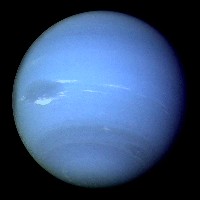 Neptune is a large gas giant planet, and is blue due to small amounts of methane floating in a thick atmosphere of (colourless) hydrogen and helium. When NASA's Voyager 2 spacecraft flew by Neptune in 1989, astronomers were amazed; instead of the dormant, dark, frigid planet they expected to see at the outer fringe of the solar system, they observed a turbulent, changing world.
Neptune is a large gas giant planet, and is blue due to small amounts of methane floating in a thick atmosphere of (colourless) hydrogen and helium. When NASA's Voyager 2 spacecraft flew by Neptune in 1989, astronomers were amazed; instead of the dormant, dark, frigid planet they expected to see at the outer fringe of the solar system, they observed a turbulent, changing world.
One of the most unusual discoveries was the 'Great Dark Spot' in the southern hemisphere, similar in size and location to Jupiter's Great Red Spot, and appearing also to be a rotating storm. Winds near the spot were measured up to 2400 kilometres per hour, the strongest recorded on any planet.
A bright cloud, nicknamed 'Scooter', accompanied the spot. When the Hubble Space Telescope viewed the planet in 1994, the spot had vanished, but a new one had formed in the northern hemisphere!
More than 30 times as far from the Sun as Earth, Neptune is the only planet in our solar system not visible to the naked eye and the first predicted by mathematics before its discovery. In 2011 Neptune completed its first 165-year orbit since its discovery in 1846.
NASA's Voyager 2 is the only spacecraft to have visited Neptune up close. It flew past in 1989 on its way out of the solar system.
The changing face of Neptune, as captured by the Hubble telescope.
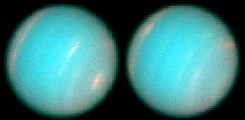
Neptune is one of the gas giant planets, all of which are in the outer solar system, beyond the asteroid belt. (The others are Jupiter, Saturn and Uranus.) Neptune is about 30 times as far from the sun as Earth is. These planets are about 4 to 12 times greater in diameter than Earth. They have no solid surfaces, but have massive atmospheres that contain substantial amounts of hydrogen and helium, and other gases.
The original gasses from which the solar system formed some five billion years ago were similar in composition. But when the sun began burning using nuclear fusion, most of the atmospheres of the inner planets, including Earth, were blown away; only the outer planets retained these huge atmospheric layers.
|
Click on the photo to see an enlarged version |
Neptune also has a ring system, although it is different than Saturn's. It is smaller and not as bright, and was once thought to have gaps; close examination by Voyager showed that this was not true ... the rings are just very faint. The main ring contains three separate regions which are brighter and denser. Several Voyager photographs show what appear to be clumps embedded in the rings. Scientists are not sure what causes the material to clump.
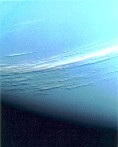 Long, bright clouds, similar to cirrus clouds on Earth, can be seen high in Neptune's atmosphere. These moving clouds help scientists estimate the speed of winds circling the planet. Clouds form this way: solar ultraviolet radiation destroys methane high in Neptune's atmosphere by converting it to hydrocarbons such as ethane, acetylene, and haze particles of more complex polymers. The haze particles freeze and become ice particles. These ice particles eventually fall into the warmer layers of the atmosphere, where they evaporate back into gases, mix with hydrogen gas and are reformed as methane. Methane clouds then rise high into the atmosphere.
Long, bright clouds, similar to cirrus clouds on Earth, can be seen high in Neptune's atmosphere. These moving clouds help scientists estimate the speed of winds circling the planet. Clouds form this way: solar ultraviolet radiation destroys methane high in Neptune's atmosphere by converting it to hydrocarbons such as ethane, acetylene, and haze particles of more complex polymers. The haze particles freeze and become ice particles. These ice particles eventually fall into the warmer layers of the atmosphere, where they evaporate back into gases, mix with hydrogen gas and are reformed as methane. Methane clouds then rise high into the atmosphere.
In northern latitudes, Voyager recorded images of cloud streaks casting their shadows on cloud decks 50 to 100 kilometers below. Cloud streaks were also seen in the southern regions.
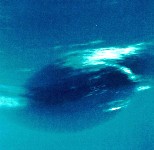 Neptune's Great Dark Spot is big enough for Earth to fit inside it. It seems to be far more variable in size and shape than the spot on Jupiter. The clouds near the Spot may be similar to clouds that form over mountains on Earth.
These clouds are pushed by winds, and circle Neptune much faster than the Great Spot does.
Neptune's Great Dark Spot is big enough for Earth to fit inside it. It seems to be far more variable in size and shape than the spot on Jupiter. The clouds near the Spot may be similar to clouds that form over mountains on Earth.
These clouds are pushed by winds, and circle Neptune much faster than the Great Spot does.
Most of the winds on Neptune blow in a westward direction, which is opposite to the rotation of the planet. Near the Great Dark Spot, there are winds blowing up to 2400 kilometres an hour ... the strongest winds measured on any planet, including Saturn.
Voyager 2 passed about 5000 kilometers above Neptune's north pole; later in its flyby, it came within 40,000 kilometers of Neptune's largest moon, Triton. Voyager 2 is one of twin spacecraft tasked with exploring the outer solar system. Between them, the two Voyagers have explored four giant planets, their systems of rings and magnetic fields, and 48 of their moons. Following their close approaches to Saturn and Neptune, Voyagers 1 and 2 are now out of our solar system, moving at speeds between 400 and 500 million kilometres per year. Both spacecraft will continue to take measurements of electromagnetic fields and particles in interstellar space and beam their results back to Earth, hopefully for many years, until their nuclear power sources cease to operate.
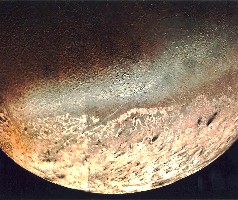 One of Neptune's moons, its largest, is Triton, and it's about the size of Earth's Moon. Because of its high density, and the fact that it's the only large satellite in the solar system to circle a planet in a retrograde direction (in a direction opposite to the rotation of the planet), some astronomers suspect that Triton was captured by Neptune several billion years ago. Triton exhibits very unusual geologic features; images show active eruptions spewing gas (probably methane and nitrogen) and dust, several kilometers into space. The particles are carried to altitudes of up to 8 kilometers, and then blown downwind, eventually to be deposited on Triton's surface. One of Neptune's moons, its largest, is Triton, and it's about the size of Earth's Moon. Because of its high density, and the fact that it's the only large satellite in the solar system to circle a planet in a retrograde direction (in a direction opposite to the rotation of the planet), some astronomers suspect that Triton was captured by Neptune several billion years ago. Triton exhibits very unusual geologic features; images show active eruptions spewing gas (probably methane and nitrogen) and dust, several kilometers into space. The particles are carried to altitudes of up to 8 kilometers, and then blown downwind, eventually to be deposited on Triton's surface.
Most of the non-crustal geologic structures on Triton's surface are likely formed of water ice, (which is rock-solid at extremely low temperatures), because nitrogen and methane ice are too soft to support much of their own weight.
A thin atmosphere, perhaps 800 kilometers high, extends above Triton's surface. Tiny nitrogen ice particles form thin clouds a few kilometers above the surface. Triton is very bright, reflecting up to 95 percent of the sunlight that strikes it (by comparison, Earth's Moon reflects 11 percent). Triton appears to have the same general size, density, temperature and chemical composition as Pluto. There is a large south polar cap visible at the bottom of the image above; it may consist of a layer of nitrogen ice deposited during the previous winter.
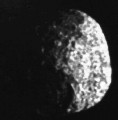 As well as the previously known satellites Triton and Nereid (discovered in 1948 by telescope, and not well studied), Voyager 2 found six more moons orbiting Neptune, for a total of eight known satellites. On the left is moon 1989N1, or Proteus, one of the darkest objects in the solar system. It reflects only 6% of the sunlight that strikes it. 1989N1 is about 400 kilometers in diameter, larger than Nereid. It wasn't discovered from Earth because it is so close to Neptune that it is lost in the glare of reflected sunlight. It circles Neptune at a distance of only 92,800 km above the clouds, and completes one orbit in about 27 hours. Hints of craters and surface grooves can be seen in the photo. As well as the previously known satellites Triton and Nereid (discovered in 1948 by telescope, and not well studied), Voyager 2 found six more moons orbiting Neptune, for a total of eight known satellites. On the left is moon 1989N1, or Proteus, one of the darkest objects in the solar system. It reflects only 6% of the sunlight that strikes it. 1989N1 is about 400 kilometers in diameter, larger than Nereid. It wasn't discovered from Earth because it is so close to Neptune that it is lost in the glare of reflected sunlight. It circles Neptune at a distance of only 92,800 km above the clouds, and completes one orbit in about 27 hours. Hints of craters and surface grooves can be seen in the photo.
Here is a useful table of facts about Neptune, which can be printed.
Resources
|